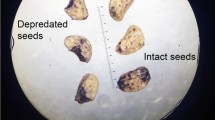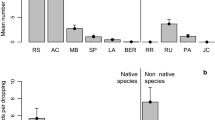Abstract
Mistletoes constitute instructive study cases with which to address the role of generalist consumers in the study of plant–animal interactions. Their ranges of safe sites for recruitment are among the most restricted of any plant; therefore, frugivores specializing in mistletoe have been considered almost indispensable for the seed dispersal of these parasitic plants. However, the absence of such specialists in numerous regions inhabited by many mistletoe species raises the question of whether unspecialized vectors may successfully disperse mistletoe seeds to narrowly defined safe sites. Using the European mistletoe Viscum album subsp. austriacum as a study case, we recorded a broad range of 11 bird species that disperse mistletoe seeds. For these species, we studied the mistletoe-visitation rate and feeding behavior to estimate the quantity component of dispersal effectiveness, and the post-foraging microhabitat use, seed handling, and recruitment probabilities of different microhabitats as a measure of the quality component of effectiveness. Both endozoochory and ectozoochory are valid dispersal mechanisms, as the seeds do not need to be ingested to germinate, increasing seed-dispersal versatility. Thrushes were the most effective dispersers, although they were rather inefficient, whereas small birds (both frugivores and non-frugivores) offered low-quantity but high-quality services for depositing seeds directly upon safe sites. As birds behave similarly on parasitized and non-parasitized hosts, and vectors have broad home ranges, reinfection within patches and the colonization of new patches are ensured by an ample assemblage of generalist birds. Thus, a parasitic plant requiring precision in seed dispersal can rely on unspecialized dispersers.


Similar content being viewed by others
References
Amico G, Aizen MA (2000) Mistletoe seed dispersal by a marsupial. Nature 408:929–930. doi:10.1038/35050170
Arruda R, Carvalho LN, Del-Claro K (2006) Host specificity of a Brazilian mistletoe, Struthanthus aff. Polyanthus (Loranthaceae), in cerrado tropical savanna. Flora 201:127–134
Arruda R, Fadini R, Carvalho LN, Del-Claro K, Mourão FA, Jacobi CM, Teodoro G, Van den Berg E, Caires CS, Dettke GA (2012) Ecology of Neotropical mistletoes: an important canopy-dwelling component of Brazilian ecosystems. Acta Bot Bras 26:264–274
Aukema JE, Martínez del Río C (2002) Where does a fruit-eating bird deposit mistletoe seeds? Seed deposition patterns and an experiment. Ecology 83:3489–3496
Bascompte J, Jordano P (2007) The structure of plant–animal mutualistic networks: the architecture of biodiversity. Annu Rev Ecol Evol Syst 38:567–593
Calviño-Cancela M (2002) Spatial patterns of seed dispersal and seedling recruitment in Corema album (Empetraceae): the importance of unspecialized dispersers for regeneration. J Ecol 90:775–784. doi:10.1046/j.1365-2745.2002.00711.x
Carlo TA, Aukema JE (2005) Mistletoe seed dispersal by a marsupial. Ecology 86:3245–3251. doi:10.1890/05-0460
Davidar P (1983) Birds and neotropical mistletoes: effects on seedling recruitment. Oecologia 60:271–273
Frick WF, Price RD, Heady PA, Kay KM (2013) Insectivorous bat pollinates columnar cactus more effectively per visit than specialized nectar bat. Am Nat 181:137–144. doi:10.1086/668595
Gómez JM, Zamora R (2000) Spatial variation in the selective scenarios of Hormathophylla spinosa (Cruciferae). Am Nat 155(5):657–668
Hawksworth FG, Wiens D (1996) Dwarf mistletoes: biology, pathology, and systematic. Agriculture handbook no. 450. Forest Service, US Department of Agriculture, Washington DC
Heleno RH, Ross G, Everard AMY, Memmott J, Ramos JA (2011) The role of avian ‘seed predators’ as seed dispersers. Ibis 153:199–203
Herrera CM (1988) Variation in mutualisms: the spatio-temporal mosaic of a pollinator assemblage. Biol J Linn Soc 35:95–125
Hothorn T, Bretz F, Westfall P (2008) Simultaneous inference in general parametric models. Biometr J 50:346–363
Ladley JJ, Kelly D (1996) Dispersal, germination and survival of New Zealand mistletoes (Loranthaceae) dependence on birds. N Z J Ecol 20:69–79
Larson D (1996) Seed dispersal by specialist versus generalist foragers: the plant’s perspective. Oikos 76:113–120
Martínez del Río C, Restrepo C (1993) Ecological and behavioral consequences of digestion in frugivorous animals. Vegetatio 107:205–216
Martínez del Río C, Hourdequin M, Silva A, Medel R (1995) The influence of cactus size and previous infection on bird deposition of mistletoe seeds. Aust J Ecol 20:571–576
Mellado A, Zamora R (2014) Linking safe sites for recruitment with host-canopy heterogeneity: the case of a parasitic plant, Viscum album subsp. austriacum (Viscaceae). Am J Bot 101(6):1–8. doi:10.3732/ajb.1400096
Montaño-Centellas FA (2012) Effectiveness of mistletoe seed dispersal by tyrant flycatchers in a mixed Andean landscape. Biotropica 45:209–216. doi:10.1111/j.1744-7429.2012.00909.x
Mullarney K, Svensson L, Zetterström D, Grant PJ (2000) Birds of Europe. Princeton University Press, Princeton
Murphy SR, Reid N, Yan Z, Venables WN (1993) Differential passage time of mistletoe fruits through the gut of honeyeaters and flowerpeckers: effects on seedling establishment. Oecologia 93(2):171–176
Norton DA, de Lange PJ (1999) Host specificity in parasitic mistletoes (Loranthaceae) in New Zealand. Funct Ecol 13:552–559. doi:10.1046/j.1365-2435.1999.00347.x
Olesen JM, Jordano P (2002) Geographic patterns in plant-pollinator mutualistic networks. Ecology 83(9):2416–2424
Punter D, Gilbert J (1989) Animal vectors of Arceuthobium americanum seed in Manitoba. Can J For Res 19:865–869
R Development Core Team (2010) R Foundation for statistical computing. Austria, Vienna
Rawsthorne J, Watson DM, Roshier DA (2011) Implications of movement patterns of dietary generalist for mistletoe seed dispersal. Austral Ecol 36:650–655. doi:10.1111/j.1442-9993.2010.02200.x
Reid N (1989) Dispersal of mistletoes by honeyeaters and flowerpeckers: components of seed dispersal quality. Ecology 70:137–145. doi:10.2307/1938420
Reid N (1990) Mutualistic interdependence between mistletoes (Amyema quandang), and spiny-cheeked honeyeaters and mistletoebirds in an arid woodland. Aust J Ecol 15:175–190. doi:10.1111/j.1442-9993.1990.tb01526.x
Reid N (1991) Coevolution of mistletoe and frugivorous birds. Aust J Ecol 16:457–469. doi:10.1111/j.1442-9993.1991.tb01075.x
Restrepo C (1987) Aspectos ecológicos de la diseminación de cinco especies de muérdagos por aves. Humboldtia 1:65–116
Restrepo C, Sargent S, Levey DJ, Watson DM (2002) The role of vertebrates in the diversification of new world mistletoes. In: Levey DJ, Silva WR, Galetti M (eds) Seed dispersal and frugivory: ecology, evolution and conservation. CAB International, Wallingford, pp 83–98
Richardson KC, Wooller RD (1988) The alimentary tract of a specialist frugivore, the mistletoebird, Dicaeum hirundinaceum, in relation to its diet. Aust J Zool 36:373–382
Sargent S (1995) Seed fate in a tropical mistletoe: the importance of host twig size. Funct Ecol 9:197–204
Schupp EW (1993) Quantity, quality and effectiveness of seed disper-sal by animals. Vegetatio 107:15–29
Snow BK, Snow DW (1984) Long-term defense of fruit by mistle thrushes (Turdus viscivorus). Ibis 126:339–349
Snow BK, Snow DW (1988) Birds and berries. A study of an ecological interaction. Poyser, Calton
Van Z (1993) Germination and seedling development of two mistletoes, Amyema preissii and Lysiana exocarpi: host specificity and mistletoe-host compatibility. Aust J Ecol 18:419–429. doi:10.1111/j.1442-9993.1993.tb00469.x
Walsberg GE (1975) Digestive adaptations of Phainopepla nitens associated with the eating of mistletoe berries. Condor 77:169–174
Waser NM, Chittka L, Price MV, Williams NM, Ollerton J (1996) Generalization in pollination systems, and why it matters. Ecology 77(4):1043–1060
Watson DM (2004) Mistletoe—a unique constituent of canopies worldwide. In: Loman M, Rinker B (eds) Forest canopies, 2nd edn. Academic Press, New York, pp 212–223
Watson DM (2012) The relative contribution of specialists and generalists to mistletoe dispersal: insights from a neotropical rain forest. Biotropica 45:195–202. doi:10.1111/j.1744-7429.2012.00905.x
Watson DM, Rawsthorne J (2013) Mistletoe specialist frugivores: latterday ‘Johnny Appleseeds’ or self–serving market gardeners? Oecologia 172:925–932. doi:10.1007/s00442-013-2693-9
Wenny DG (2001) Advantages of seed dispersal: a re-evaluation of directed dispersal. Evol Ecol Res 3:51–74
Zuber D (2004) Biological flora of Central Europe: viscum album L. Flora 199:181–203
Acknowledgments
We are grateful to Ramón Ruiz Puche for his excellent work in the field, Tomás A. Carlo for his constructive comments on an earlier version of this manuscript, Julia Koricheva, David M. Watson and Rafael Arruda for their helpful comments as reviewers of the manuscript, and David Nesbitt for checking the English of this paper. We thank the Consejería de Medio Ambiente (Junta de Andalucía) and the Director of the Sierra de Baza Natural Park for permission for the field work. This study was supported by the Spanish Ministry of Science and Innovation (MICINN) projects MUERDAME CGL2008-04794 and CLAVINOVA CGL2011-29910 and a FPI grant BES-2009-023219 to A. M. G. from the Spanish MICINN.
Author information
Authors and Affiliations
Corresponding author
Additional information
Communicated by Julia Koricheva.
Rights and permissions
About this article
Cite this article
Mellado, A., Zamora, R. Generalist birds govern the seed dispersal of a parasitic plant with strong recruitment constraints. Oecologia 176, 139–147 (2014). https://doi.org/10.1007/s00442-014-3013-8
Received:
Accepted:
Published:
Issue Date:
DOI: https://doi.org/10.1007/s00442-014-3013-8




